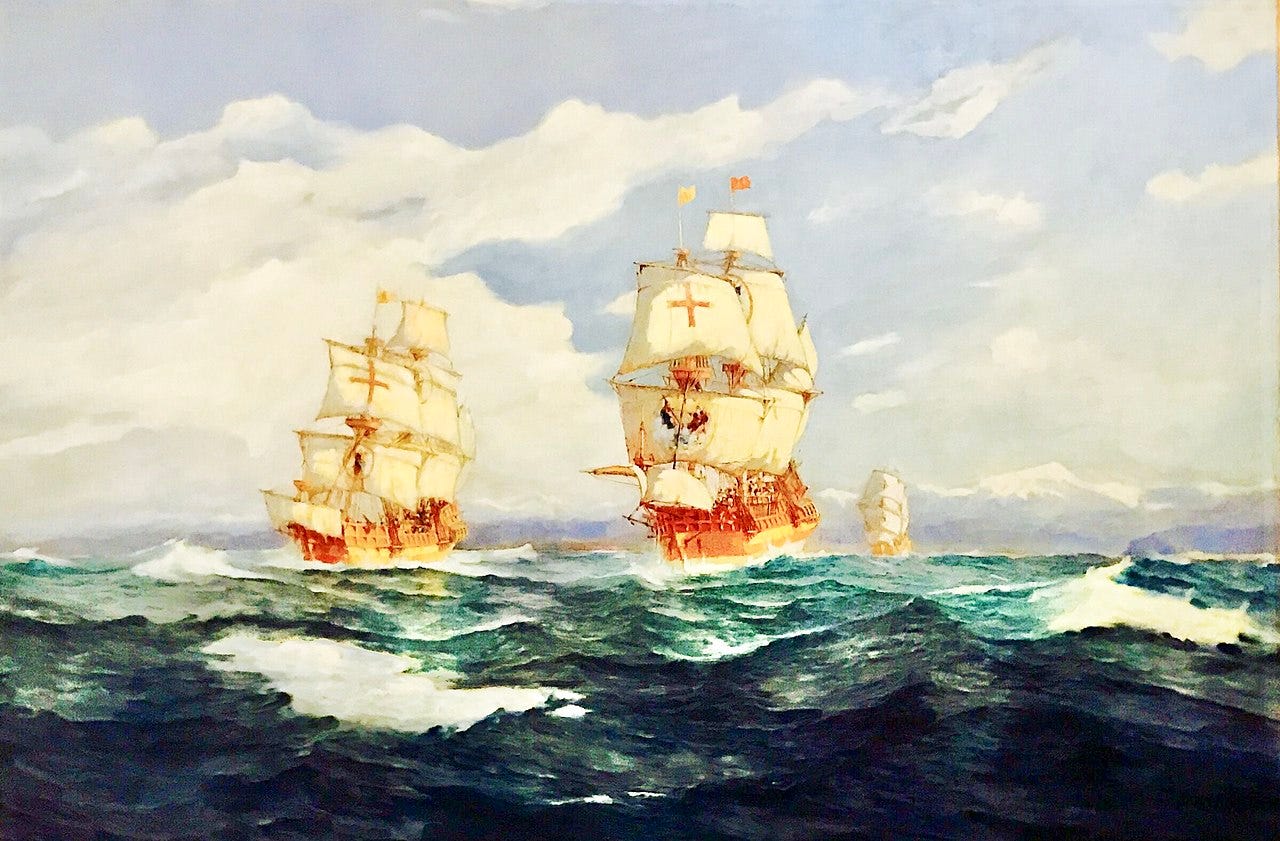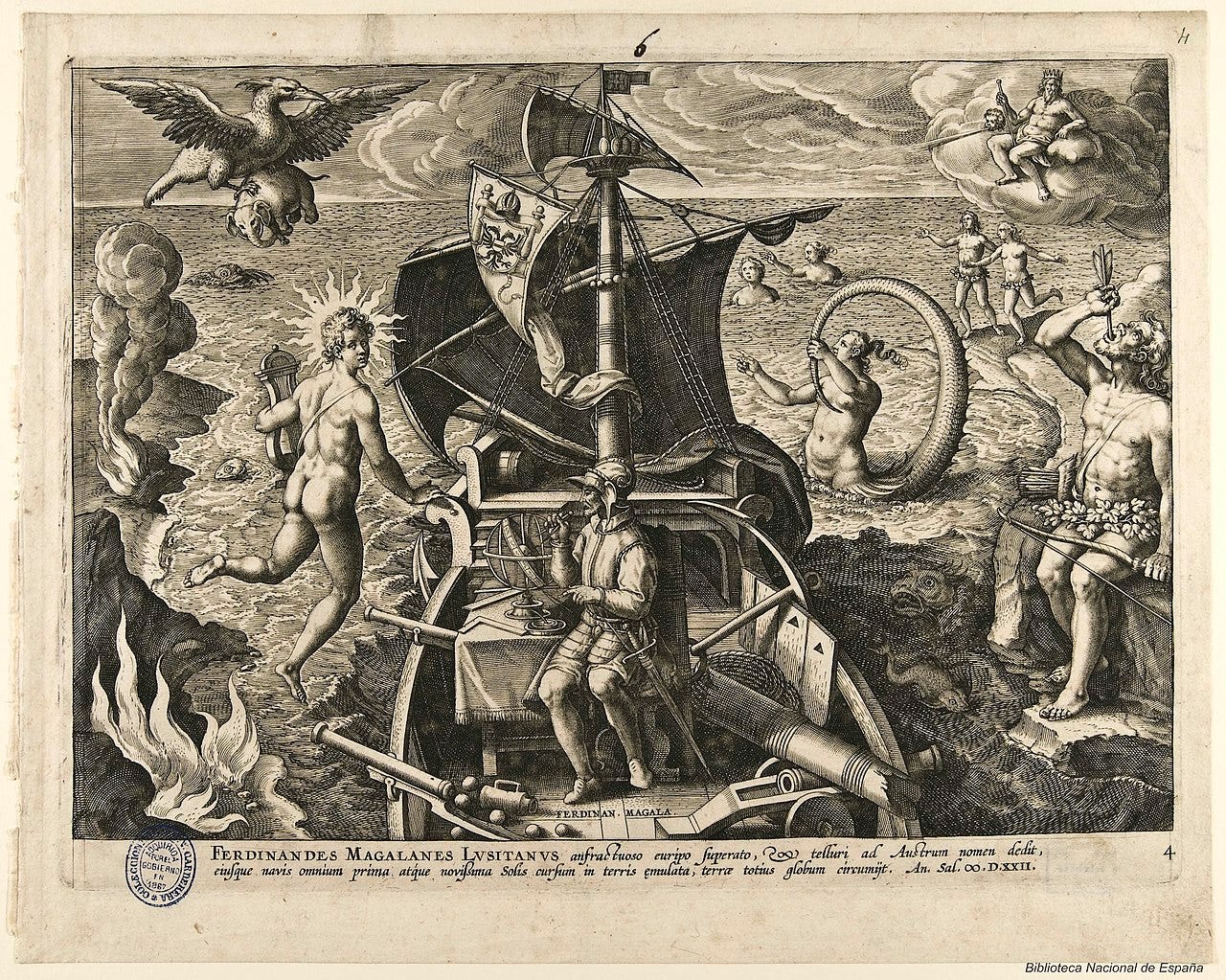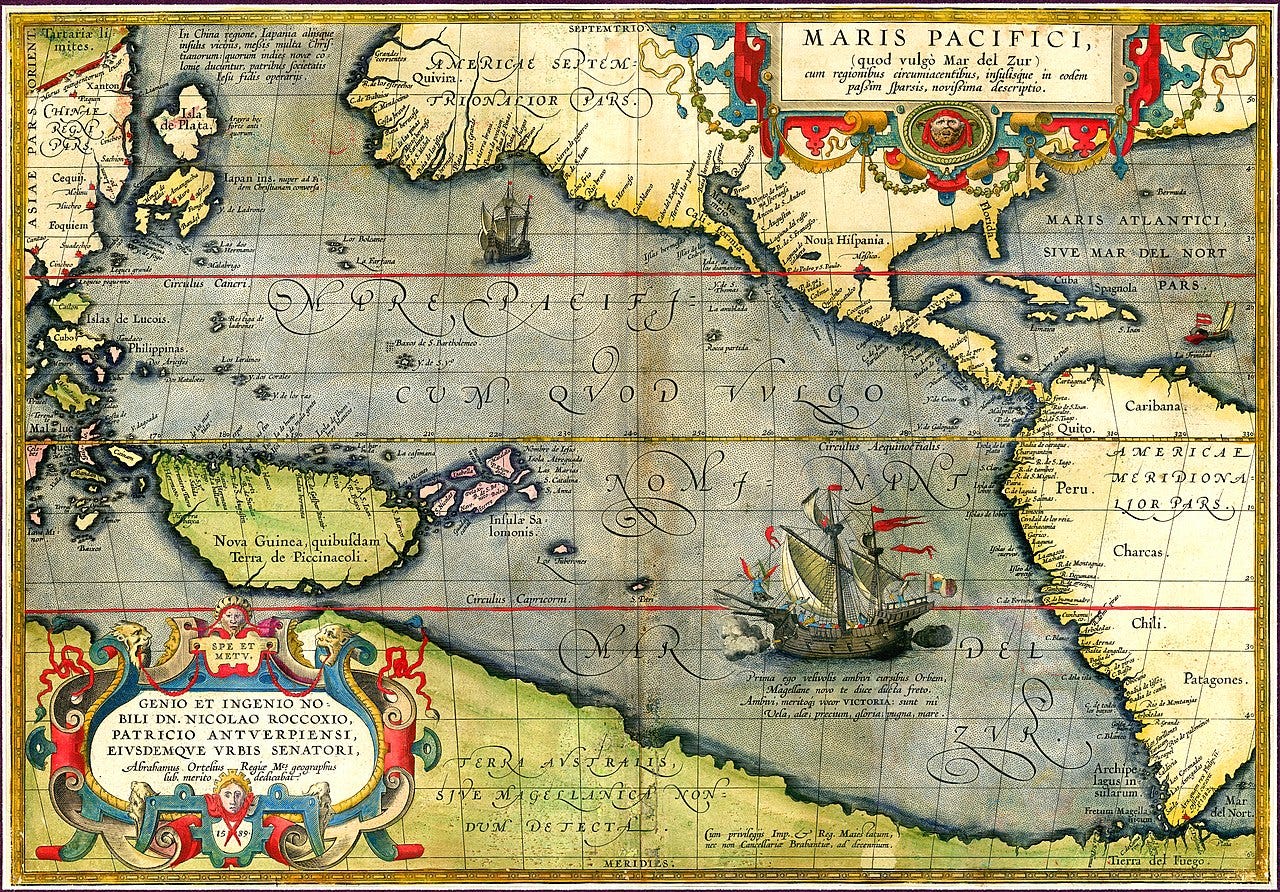The Glorious (And Seriously Deadly) First Trip Around The Globe
Magellan’s courageous journey helped to interconnect the world
One of history’s most important journeys began 504 years ago this day: Ferdinand Magellan, or Fernão de Magalhães as he was known in his native Portuguese, began a sailing expedition that would circumnavigate the globe.
Magellan had a wealth of sailing experience under his belt when he began his journey in 1519. He’d served the Portuguese crown for years on missions that had taken him far and wide expanding the Portuguese Empire’s influence. Ambitious men like Magellan were willing to undertake risky exploration and military missions abroad in search of something we now find easily on supermarket shelves—spices.
Discovery Of The Strait Of Magellan. Alvaro Casanova Zenteno, 1925. National Historical Museum, Santiago, Chile/Wikimedia.
Today we take for granted our access to spices like nutmeg, black pepper, and cloves, but for 16th century Europeans, these spices were worth their weight in gold. They flavored, preserved otherwise bland food, and had “ritual, religious or medical uses,” making their trade extremely lucrative.
Europeans imported their spices from Asia, specifically from major hubs like India and the “Spice Islands” in modern day Indonesia. During the Middle Ages, spices made their way from these far-flung places to Western Europe via the Middle East. Italian seafaring republics—most prominently, Venice—had a stranglehold on the spice trade, buying in the Middle East and selling in Western European ports at massive upcharges. Other European powers sought to break this monopoly by cutting out the Italian middlemen and going straight to the source by finding a maritime route to India and East Asia.
By Magellan’s time, such a route had already been discovered by Portuguese explorers Bartolomeu Dias and Vasco de Gama, who had sailed east around Africa and (in de Gama’s case) into the Indian Ocean. What Magellan proposed to do, however, was different—the explorer intended to reach Asia by sailing not east, but west.
Magellan took this plan to Portuguese King Manuel I, who repeatedly refused to fund the expedition, forcing Magellan to seek sponsors elsewhere. His entreaties fell on more willing ears in Spain, where King Charles I agreed to support the expedition.
Magellan’s proposal intrigued the Spanish monarch because it offered a potential new avenue for Spanish wealth. Under the 1494 Treaty of Tordesillas, Portugal and Spain agreed to divide the globe into spheres of influence, with Portugal controlling territories and trade routes east of a line that fell roughly in the middle of the Atlantic Ocean and Spain controlling everything to the west. Because Magellan proposed to reach the Spice Islands through a new western route, this plan offered Spain a chance to tap into the eastern spice trade without technically violating the terms of the agreement, accessing Asia “through the back door,” as one scholar put it.
With backing from his new sponsor, Magellan set sail on September 20, 1519, from the Spanish port of Sanlúcar de Barrameda with five ships and 270 men—drawn primarily from Spain and Portugal, but also sailors of other nationalities.
The voyage’s ensuing few years were hardly a pleasure cruise. Magellan and his men crossed the Atlantic Ocean and then began sailing south along the South American coast, searching for a path west. Along the way, the squadron suffered attrition to mutinies, shipwreck, and desertion, but after a year of hardship, Magellan finally found what he had been looking for.
The discovery of a passageway to the other side of the world, Joannes Stradanus, ca. 1592. Biblioteca Nacional de España/Wikimedia.
The incredibly difficult-to-navigate Strait of Magellan—since named after the man himself—was the gateway to the west that the Portuguese sailor had been seeking. Magellan named the ocean he found on the gateway’s western side the “Pacific Ocean”—meaning “calm” or “peaceful” ocean—due to its contrast with the turbulent strait he and his men had just navigated.
But crossing the strait wasn’t the end of Magellan’s problems. The Pacific was massive–much larger than the Europeans had imagined–and they sailed for three months before finally finding land, all the while suffering hunger, dwindling supplies, and the universal scourge of sailors at the time: scurvy.
But, in the spring of 1521, Magellan reached the island of Guam before going on to explore the archipelago later known as the Philippines (being named after Philip II, future king of Spain). But tragically, Magellan became involved in an inter-tribal conflict on Mactan island, where he fell in battle on April 27, 1521, at the age of 41.
Though Magellan died, his shipmates continued on. Juan Sebastián de Elcano, a Basque sailor and Magellan’s right-hand man, took command and led the expedition to its ultimate goal, the Spice Islands (also known as the Moluccas or Maluku Islands), where the remaining ships took on a rich cargo of cloves, before setting sail for Spain.
Sailing across the Indian Ocean and up Africa’s west coast, Elcano finally arrived in Sanlúcar de Barrameda, the port from which they’d set sail, on September 6, 1522. Nearly three years had passed; the only surviving ship was the aptly named Victoria. The men were ragged, their original leader was dead, and only one ship and eighteen men remained from the original complement of five ships and 270 sailors.
But the mission was complete, and Magellan posthumously proved that there was indeed a western route to the east. The Spanish monarch Charles I gave Elcano a generous annual salary and a crest: a globe with the motto “Primus circumdedisti me,” a Latin phrase meaning “You were the first to circumnavigate me.” As for the ship’s cargo, its 381 sacks of cloves bought in the Spice Islands were “worth more than the cost of the original five-ship armada.”
The Victoria sails through a map of the Pacific Ocean. Abraham Ortelius, 1589. Raremaps.com.
Magellan succeeded, even if Spain didn’t initially use his route due to its difficulty. The Spaniards later conquered the Philippines, which, added to their possessions in South America and elsewhere, turned Spain into one of the first empires upon which “the sun never set” (next to Portugal, which also had widespread colonial possessions overseas). The Spanish territories of Mexico and the Philippines would become linked by the famous “Manila Galleons,” ships that brought “porcelain, silk, ivory, spices, and myriad other exotic goods from China to Mexico” and onward to Europe as well.
Magellan’s journey also provided a treasure trove of geographical discoveries to Europe’s mapmakers and geographers. The science of geography was improved tremendously by Magellan’s discoveries.
Magellan and his contemporary Europeans felt a sense of discovery and wonder we can hardly imagine: some have compared his journey to the moon landings of their age. Today, we take geographical knowledge for granted; Google Image searches reveal the world in seconds. But in the Age of Discovery, maps were filled with blank spaces—a terra incognita waiting to be filled by Magellan,Elcano, and other intrepid explorers who overcame unimaginable hardships to pull back our veil of ignorance.







